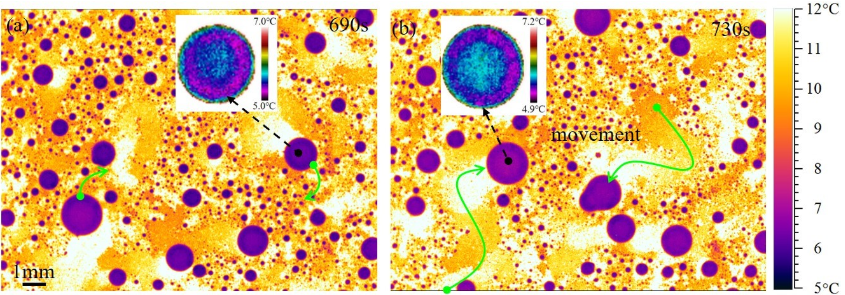Drop-wise condensation has become a hot topic because of its heat transfer efficiency that is about ten times higher than that of film condensation. However, even if the surface properties such as substrate roughness and wettability remain unchanged, with more condensation droplets, the droplets become increasingly easier to merge into film state. Therefore, the key to maintain droplet condensation is to drain the droplets in time. The gravity can only drain the droplets with diameter greater than the capillary length (2.7mm for water), and the direction is always vertical and downward. With the condensation droplets converging at the bottom of the substrate, it is inevitable to transform into the membrane state. In recent years, the phenomenon of spontaneous migration and jumping of droplets has been discovered. However, only on the superhydrophobic surface will micro droplets merge with each other and jump, and the energy conversion efficiency is quite low; on the porous surface filled with lubricating oil (homogeneous super smooth surface), the smaller droplets are driven to move to the nearby larger droplets by the capillary force between the droplets, but only for the micron scale (generally with diameter < 100 μ m) droplets; the droplets with diameter between 100 μ m and capillary length are able to migrate on special surfaces such as gradient wet surface, super smooth hydrophilic surface of like rice leaf, and dot like protuberance of desert beetle's back shell, but they can only move along the pre-processed direction. This process is still capillary movement in essence. The most important thing is that condensation itself is a strong heat transfer process, and the existing self-driving moving direction has nothing to do with heat transfer. There is at present no self-driving mechanism that can drain droplets of various sizes (micron to millimeter) without external force, and the direction is closely related to heat transfer.
Recently, the research group led by Professor Shi Wanyuan has prepared a new type of heterogeneous super smooth surface by chemical etching followed by coating with polytetrafluoroethylene. It was found that condensation nucleation occurred preferentially near PTFE particles, which leads to local temperature inhomogeneity on the condensation surface. It was observed that the condensation droplets on the horizontal super sliding surface moved spontaneously from the high local temperature region to the lower temperature region without external force and horizontal temperature gradient (Fig. 1). It was also found that it was driven by the thermocapillary force (thermal Marangoni effect) between the droplet bottom surface and the liquid film on the super sliding surface due to the uneven local temperature distribution on the condensation surface. As long as there was temperature inhomogeneity on the surface of the condensing substrate, the droplets on it would move. The movement further aggravated the surface temperature inhomogeneity and enlarged the geometric range, so that droplets with diameters ranging from tens of microns to several millimeters could move. On the inclined wall, droplet with diameter of about 1.0 mm could even move upwards against gravity. The velocity of droplet motion is proportional to the Marangoni number Ma. The advantage of the droplet moving to the lower temperature region was that the low temperature region is more conducive to condensation, and the movement also accelerated the sweeping and merging of the droplets, which is not reliant on gravity. The condensation efficiency was improved by the combined action of various factors. The experimental results showed that the mass of condensate collected at the bottom of condensation surface in the presence of thermal capillary migration could be twice as high as that without thermal capillary migration. The discovery is believed to have promising application prospects in areas such as seawater desalination, air intake, and space microgravity thermal management.
This achievement was recently published online in Applied Physics Letters, a natural index journal under the title Spontaneous thermocapillary motion of condensation droplets. Professor Shi Wanyuan is the corresponding author, Doctoral Candidate Zhu Jilong is the first author, and Doctoral Candidate Wang Tianshi and Post-doctor Feng Lin are the third and fourth authors respectively. This Project has been supported by the National Natural Science Foundation of China (No. 51676018).

Self-heating capillary motion of condensate droplets on a horizontal super smooth surface, with arrows showing the path of droplet movement
Link of the full paper: https://aip.scitation.org/doi/10.1063/5.0007074
